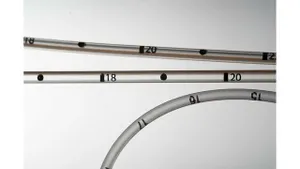Light bulbs to LEDs: Philips Vitrite rapidly develops its sustainable future
The light bulb manufacturing business left for low-cost manufacturing shores, leaving Philips Lighting Vitrite, Philips' captive component manufacturer of general lighting systems (GLS)-your standard light bulb-in need of a new business model. Injection molding became the rallying cry, and the company now is on the leading edge of LED design. Furthermore, it intends to be on the leading edge of lighting systems for many years to come.
August 17, 2011
"To be successful in such a turnaround, you need to rely on your own strength," is how Rob Lous, commercial manager in charge of purchasing, marketing and sales, recalls those transition days. Middelburg, the Netherlands, where the business is based, and the surrounding area, is a part of the country that has seen hard times but where the citizens are known for their resilience. "In these parts, the motto is, 'You can knock us down but we'll just get back up,'" noted Lous during a visit by PlasticsToday to his facility.
Vitrite was actually founded a few years before Philips in the latter stages of the 19th century, became one of the latter's leading suppliers, and eventually was acquired by Philips. Vitrite was in the GLS manufacturing business from 1893 - 2002, manufacturing 3-4 billion of the caps for such light bulbs annually. But manufacturing of these began to shift in the 1990s, quickly, to low labor-cost countries, and so the company's management recognized they needed to revamp.
The plans for a revamped business model began to take hold at the turn of the century, though GLS still accounted for ¾ of revenue as late as 2005/06. But by 2007/08, the company had switched almost its entire operation to automated injection molding cells, at first mostly for automotive lighting systems and then since 2009 increasingly for the production of LEDs (light emitting diodes).
Plastics expert helps guide the change
Helping steer the revamp is Victor Geelen, senior plastics engineer, who joined Vitrite from Philips' plastics processing operations in 1996 to help the light bulb company transition to a plastics processing one. Geelen and management realized that simply processing plastics would not be enough to fend off low-cost threats, so they decided to aim at the upper end of the plastics food chain. "We're among the largest users of PPS in Europe," explained Geelen, and added that many of the special LED compounds processed by the company have costs measured in the 100s of Euros per kilogram.
"We changed our entire strategy, from mass manufacturer (of GLS) to an innovation center," added Lous. It seemed a fine idea but the new business at first was largely dependent on the automotive lighting industry, which in 2008/09 collapsed along with everything related to automotive.
Coming out of the recession, automotive sales improved and with them so too did Philips Vitrite's results. Moving forward, the company is actively shifting its portfolio so that it is less reliant on automotive halogen and Xenon lamps components, and increasing its output of sophisticated LED production. Sophistication and differentiation is critical, said Simon Flink, innovation manager. Ten years ago, the company's competition was Osram and GE. Now, in the LED market, the number of competitors is much higher, he noted.
New technology figures big in the processor's future, as does greater involvement in early-stage design. "Customers appreciate our ability to tune in to new technology as well as to keep our costs low," explained Lous. Turnover now is back to pre-'07 levels. "Our goal is to be with our customers from the start of their development for the housings and lamps," added Geelen.
Currently it is not difficult to find that customer as all of the company's production is captive for Philips, but that is set to change as it expands its customer base. "We expect new business to account for ¾ of our revenue by 2020 as we phase out established products and introduce new ones," commented Lous.
Insert molding masterpiece
Leaving the managerial offices, we turn into the company's large manufacturing facility. The company claims two core technologies. One is forming of metal-mostly Chrome steel- at high speeds and still maintaining very high precision! This is a skill it perfected in more than a century of light bulb component manufacturing, with the work done on high precision presses ranging from 30 ton to 150 tons. The tooling is being produced outside but engineering still is done in-house. This is considered crucial to be able to really optimize the second core technology.
That second core technology is high-precision insert molding, fully automated and with very high-end tooling. The plastics it runs-PPS, LCP, PPA- have operating temperatures up to 200°C and are very expensive, with very high demands on dimensional tolerances.
Scrap for such high-end material is of course unwelcome. The company develops most of its automated assembly equipment in-house, with this assembly reaching a rate of a blazing 1000 pieces/minute. Vision Q/C equipment on 100% of the output ensures that parts shipped are within spec. "We count our defects in PPM levels, low PPM levels," states Geelen with pride.
One of the new plastics developments has been the redesign of the company's H7 lamp, with the redesign including a switch from thermoset plastics to thermoplastics. The transition and development took two busy years. These bulbs are molded on a 32-cavity mold with three metal inserts per cavity, for a total of 96 inserts per cycle in a 130°C tool. The moldings are polyphenylene sulfide (PPS) with 70% glass fiber filling, direct gated on the part. The company has an annual capacity of 70 million pieces of these. "The idea started as cost reduction but it became a huge quality improvement innovation," said Geelen.
The company's machine park is mostly branded Arburg, though an Engel machine is running that 32-cavity multi-metal insert project, and a new KraussMaffei robot was just installed. Production cells are formed from three molding machines, with an extra mold available for each cell.
The company does its own mold design but outsources their production; mold maintenance is handled in-house. The company's experience in high-speed metal stamping has helped it on many injection molding fronts, to include with regard to maintenance of its molds. Most of its mold manufacturing is handled by a small group of mold makers in the region. Every eight weeks the employees in the mold overhaul shop do a mold teardown and perform preventive maintenance. "We handle first-line maintenance of the molds and machines," explained Geelen.
Priamus scientific molding hardware and software is used to monitor the cells. Mold-Masters has been a partner for Philips Vitrite since it began injection molding and supplies the hot runner systems for all but one mold in the plant. Neureder, now part of KraussMaffei, supplied most of the insert and parts' take-out automation in the plant. Central drying and materials handling for twelve molding machines processing Ryton and Fortron brand PPS is handled with equipment from Piovan.
There are five shifts with the plant running 24/7. Geelen explains that although the company has stuck with standard mold cooling (no contour cooling), "Because we're involved at the beginning (in design), we ensure they're optimized." The molds also are designed so components can be easily changed out, if necessary.
A bright future in LED molding
For production there are seven cells of three injection molding machines each. A Chinese/Dutch team of employees was going over a new three-machine cell being assembled for a new partner in China on the day we visited.
Parts are placed in trays and then run through ovens to degas them. They then are run through a quality control system that takes pictures from six different angles, of every part. The vision control systems are all custom-made, with these fully integrated into each molding machine's operation before and immediately after molding. Rapid feedback from these is critical as a misplaced metal insert can cause damage to very expensive molds. "Our goal isn't vision control to find rejects, our goal is process control to prevent them in the first place," said Geleen.
The trays of inspected parts usually are shipped to the Phillips facility in Aachen, Germany, about 3 hrs away.
The only electric press in the plant is an Arburg Alldrive 520. "On the all-electric, we've seen that the positioning is a bit more precise for this specific project, so we could save a bit on the robot," explained Geelen.
Existing LED lamps have an expensive housing of diecast aluminum; replacing this with a plastic insert molding is one of the company's goals. "We're already recognized as a design partner, so we are directly involved in development of next-generation LEDs," said Lous.
The company is on the leading edge of LED design, and recently entered one of its models, the Endura, into a U.S. Dept. of Energy (DoE) competition for future lighting. The caps for the Endura LEDs are molded on an Arburg 320C press.
Helping Philips in China
To meet customers' demand for an overseas production facility, the company is eyeing potential alliance partners in China. Testing is ongoing with a Chinese partner and production equipment is being installed there now. This Chinese partner will supply to a Philips plant in China. During PlasticsToday's visit, eight of the Chinese employees were in the Dutch plant. Training goes on for three months before the Chinese workers return to their parent company.
But Philips Vitrite managers also predict a long and prosperous future in their homeland. "Craftsmanship plus creativity" is how the group describes its strengths, and the reason management believes in its success going forward.
[Ed.: Thanks to Jos van den Heuvel of Mold-Masters Europe for arranging our visit. We asked Mold-Masters to comment on its cooperation with Philips Vitrite:
"Reliable solutions for injecting high-end technical materials and handling the very high temperatures within the hot runner systems - sometimes up to 400 °C and up to 130 °C in mold temperatures - is a unique technology that requires a dedicated approach. The highly abrasive wear on mold and systems, based on the 70% glass in mineral filling in the used materials at Philips Vitrite, also add a special challenge when it comes to high quality part molding for lighting parts. For Mold-Masters, lighting solutions have always been one of the core competences - from rear and front lights, from automotive halogen and Xenon lamps to latest LED developments. Same as for large part applications, under the hood parts, housing or lenses - when it comes to engineering grade resins it requires an individually engineered solution for each individual segment.
Based on a long-term partner approach, the solutions Mold-Masters provides to Philips Vitrite are an excellent example of how today's co-operative project management across company borders is being utilized to create leading innovation products. Continuous involvement from design to manufacturing provides high value to both company's co-development strategy and creates products that really satisfy global market needs - all at a quality level that is unique in the industry."]
About the Author(s)
You May Also Like


